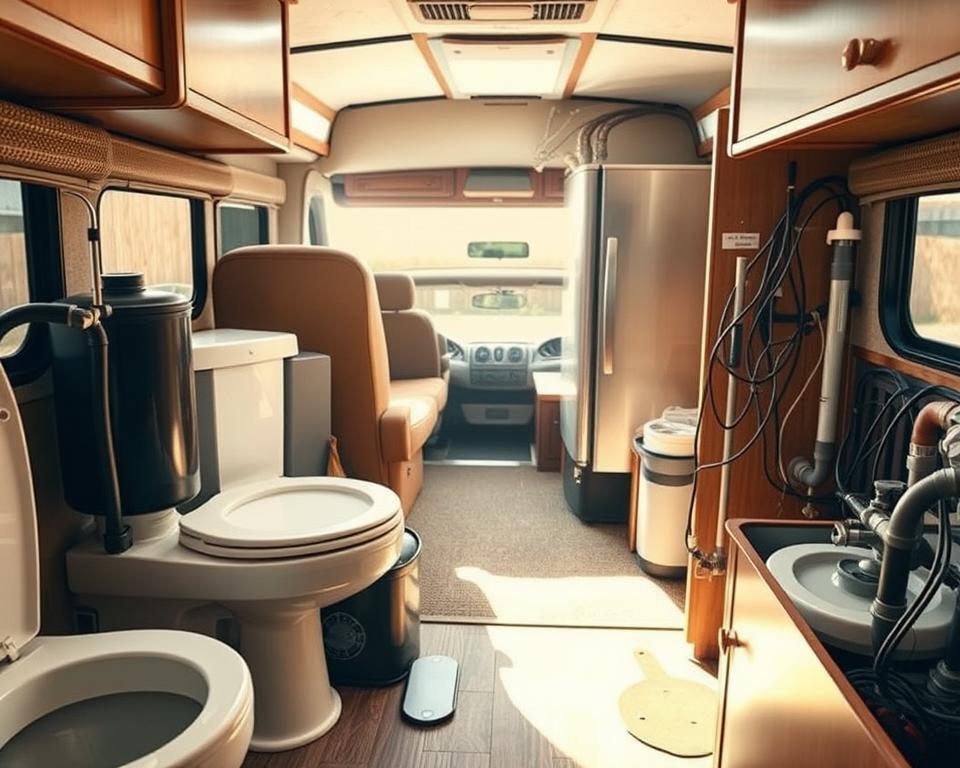Camper Water Tank and Pump: Essential Manual
Have you ever questioned how seasoned RVers maintain perfect water flow while touring? It’s all about your RV water Tank & Pump. Be it venturing into national parks or a simple weekend retreat, understanding your RV’s water system is crucial. This article we dive into the basics: the elements, upkeep, and tips for worry-free travel. Knowing each element, from the plumbing network to reservoir filling, ensures water is always available during your journeys – RV water tank and pump.
Vital Observations
- Getting familiar with the RV water system enhances your travel experience.
- The RV fresh-water Tank & Pump are indispensable for a dependable water supply.
- Routine upkeep ensures the lifespan of your RV plumbing.
- Knowing proper fill techniques for your reservoir properly can prevent future issues.
- Fixing your water Pump can spare you sudden problems.
Demystifying RV Water Systems
RV water systems consist of two principal parts: the fresh-water setup and the grey/black-water mechanism. The fresh side features several critical pieces like the storage Tank, Pump, and faucets, resembling home plumbing but adapted to the mobile needs of life on wheels.
Using clean water is non-negotiable for the system’s efficiency. It protects the safety of all passengers. It’s imperative to keep the RV plumbing in excellent order through scheduled maintenance – including proper drainage to avoid leaks and other issues. Timely inspections let RV enthusiasts sidestep water-related mishaps during their journeys.

Why You Need the RV Water Tank
The RV water Tank is pivotal for a smooth journey. It holds the fresh water necessary for drinking, cooking, and cleaning. The capacity of this Tank changes with each RV model, determining how much water can be stored – and has a direct bearing on how long you can roam before requiring a refill.
Maintaining the RV storage Tank hygienic is vital. Regular cleaning prevents harmful contaminants, so the water stays safe for use. Ignoring maintenance can encourage bacteria or algae growth, rendering the water hazardous.
Recognising the RV water Tank’s role streamlines water management on the road. Consistent upkeep and regular refills ensure a stress-free experience. It’s key to have ample water for all travel needs, ensuring a smooth RV adventure.
Filling Your RV Water Tank
Filling your RV water Tank demands careful action to ensure it’s done correctly. There are two primary methods: gravity filling and city-pressure filling. Understanding these methods noticeably enhances your RV experience.
Gravity filling is simple. All you need a drink-safe water hose. Attach this hose to a water source, then to the Tank’s opening, and allow gravity take over. Always watch the water level to avoid spills.
Using city pressure relies on a city water connection, which is faster fill times. You must use a pressure regulator to control water flow. Attach the hose from the municipal source to your RV. This approach delivers speedy and consistent supply to your reservoir.
Whichever method you use, follow these vital safety tips: Always monitor the Tank when filling to prevent overflow, and draw only safe water to avoid health issues. Knowing these filling and safety techniques will make your RV trips even more enjoyable.
RV Water Tank and Pump: Parts in Focus
The RV Tank-and-Pump combo are critical to any RV’s plumbing system, delivering a steady and smooth water supply for all your needs. The RV water Pump’s main job is to push water from the Tank, ensuring clean water is always ready. That’s vital for cooking, cleaning, and showering.
RV plumbing utilises different Pump types, each with individual benefits. Diaphragm pumps are prized for their steady water pressure, while centrifugal models are loved for mechanical simplicity and energy thrift. It’s essential to weigh flow rate, noise, and installation ease when picking your Pump.
To wrap up, the RV Tank-Pump pair are indispensable to your water system’s operation. A robust Pump delivers strong pressure and smooth flow, boosting your overall travel experience.
Choosing the Right RV Pump
Choosing the ideal RV water Pump is essential for your plumbing’s optimal performance. When shopping for a Pump, considering a few points is important for a positive camping experience. Ensuring it pairs with your RV’s water system is key.
Keep these important aspects in mind:
- Flow Rate: Opt for a Pump with a flow rate that matches your usage needs. A stronger flow means faster reservoir refills.
- Pressure Ratings: Your RV’s various fixtures set the required pressure levels. Go with a Pump whose specs align with those figures for smooth operation.
- Noise Levels: Noise can be an issue with some Pumps. For a calm cabin, compare models for their noise output.
Brands like Shurflo and VEVOR are among the top picks for many RVers, each offering unique features. A thoughtful assessment of these brands will assist your selection process.
Understanding these factors is not only important for the proper purchase but also equips DIY enthusiasts with essential know-how for upkeep and replacements.
Connecting to City Water for Your RV
Hooking your RV to city water allows for an uninterrupted supply of fresh water, freeing you from just using your Tank. This ensures a more convenient camping experience. Make sure to follow proper steps for a successful hookup.
First, locate the city water connection port on your RV. It’s commonly marked by a white or black connector, sometimes marked for ease. Use a potable water hose made for RVs; this kind of hose maintains your water safe from contaminants.
It’s wise to attach a pressure regulator before making the connection. This device protects your plumbing by taming the water pressure. With the regulator in place, connect the hose from it to the water source.
Once connected, watch the water pressure. Maintain a steady, gentle flow to avoid hose damage. Inspect your hoses regularly for any wear or leaks and quickly replace parts as needed.
Following these steps for city hookup boosts your camping convenience and helps in maintaining your RV’s condition.
Caring for Your RV Fresh-Water Tank
Making sure your RV’s water Tank is in good order is vital for safe, clean water while out on adventures. A well-maintained Tank wards off bacterial growth and contamination. First up, regularly sanitise the Tank: combine water with a bit of bleach for an efficient residue-free clean.
It’s crucial to watch for leaks and control Tank pressure. Regular checks can identify problems early, avoiding expensive fixes. A solid schedule keeps the water system in prime condition.
To optimise maintenance, create a checklist:
- Check water levels and quality frequently.
- Sanitise the Tank twice a year with a bleach solution.
- Inspect for seepage in the reservoir.
- Monitor Tank pressure and Pump function.
- Flush the Tank to clear any sediment buildup.
RV Water Pump Problem-Solving
RV water Pump issues can be annoying, derailing travel plans without warning. Facing strange noises, experiencing low pressure, or suffering complete Pump failure are typical problems. Understanding how to troubleshoot these issues can significantly enhance your trips.
Hearing odd sounds from your Pump is usually a problem. First step is to check for loose connections and secure them. When confronted with low water pressure, inspect hoses and fittings for leaks. Even a tiny leak can greatly affect flow, early troubleshooting is essential.
If your Pump quits altogether, check electrical connections. Start with examining the Pump’s fuse. If the fuse is fine, continue diagnosing for wear or damage.
A systematic routine isolates and rectifies water system issues. Routine maintenance and inspection secure hassle-free journeys.
| Issue | Possible Cause | Suggested Solution |
|---|---|---|
| Strange Noises | Loose connections | Tighten fittings |
| Low Pressure | Leaky hoses/fittings | Find & seal leaks |
| Pump Failure | Electrical fault | Check fuse/wiring |
| No Water Flow | Blocked lines | Flush obstructions |
Hacks for Effective RV Water Use
Camping in remote areas often means limited water access. Economical use in your RV is vital. By adopting smart conservation tactics, you not only manage resources well but also elevate camping satisfaction.
To make the most of water while travelling, try these tips:
- Take quick showers – aim for under five minutes.
- Install water-saving fixtures like low-flow showerheads and faucets.
- Reuse used water: dishwater can flush toilets or water plants.
- Monitor reservoir levels regularly to prevent overflow.
- Plan water stops in advance: know filling stations along your route.
The Bottom Line
Mastering the intricacies of your RV water systems is central to a satisfying travel adventure. The Tank and Pump are at the core of this, needing routine upkeep. By looking after these systems, you secure a dependable supply and sidestep potential snags.
Routine troubleshooting and checks fetter stress and spare time. Being proactive about upkeep is essential, especially when you’re far from help. Proper care enables you to maximise water use, boosting comfort for everyone.
On your next outing, keep this guide to tame your RV’s water systems. Smart decisions about plumbing and equipment prepare you to embrace the freedom of the road. Enjoy joyous and smooth travels ahead!


